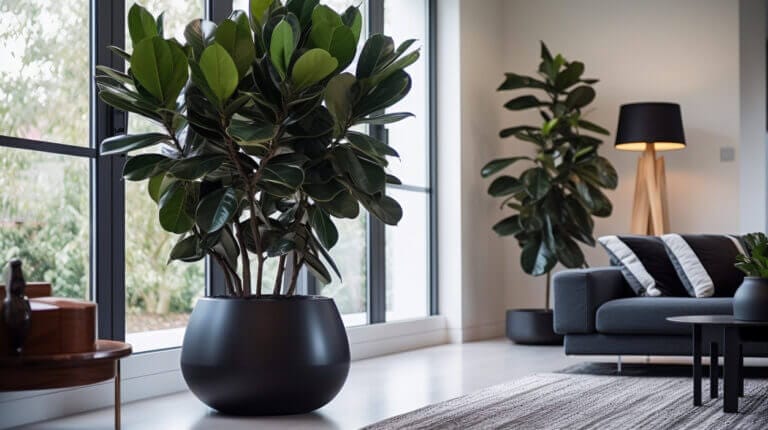How to Repot a Rubber Tree Plant: A Comprehensive Guide
As a proud owner of a rubber plant, you know that taking care of it is essential to keep it thriving and healthy. One important aspect of plant care is repotting. In this guide, I will walk you through the step-by-step instructions on how to repot your rubber plant, so you can continue enjoying its beauty and benefits.
Why Repotting a Rubber Plants
Repotting your rubber plant is crucial for its overall growth and well-being. Over time, the plant’s roots can outgrow the current pot, leading to root-bound conditions. By repotting, you provide your rubber plant with a fresh, nutrient-rich environment, allowing the roots to spread and establish properly. This results in healthier foliage, better nutrient absorption, and overall plant growth.
When is the Time to Repot Rubber Tree Plants
There are a few sign that your rubber plant may need to repot. indicate it’s time to time to transplant or repot your rubber plant:
1. Root Bound: If you notice roots growing out along the edges of the drainage holes, it’s a clear signal that your rubber plant needs more space.
2. Slow Growth: If your rubber plant has been growing slowly or has stopped growing altogether, it may be a sign that it has outgrown its current pot.
3. Wilting or Yellowing Leaves: Excessive wilting or yellowing of leaves can indicate that the roots are struggling to get enough nutrients due to a lack of space.
To repot your rubber plant, follow these simple steps:
- Pick a pot that is 2-4 inches larger in diameter than the current pot.
- Gently remove the rubber plant from its current pot, being careful not to damage the roots.
- Place a layer of fresh, well-draining potting soil in the bottom of the new pot.
- Carefully transfer the rubber plant into the new pot, ensuring that the root ball is centered and the plant is upright.
- Fill the remaining space with potting soil, firming it gently around the roots.
- Water the plant thoroughly and place it in a suitable location with indirect sunlight.
- Keep an eye on the moisture levels and adjust watering as needed.
Preparing for Transplant or Repotting Rubber Plants
Choosing the right pot size
When it comes to repotting your rubber plant, selecting the right pot size is crucial for its health and growth. You want to choose a pot that is slightly larger than the current one, allowing room for the roots to spread and grow. This will give your plant the opportunity to thrive and reach its full potential. Remember, a pot that is too large can lead to overwatering and root rot, so be mindful of the size you choose.
Gathering necessary tools and materials
Before you begin the repotting process, gather all the necessary tools and materials. Here’s what you will need:
- Potting soil: Choose a well-draining potting soil specifically formulated for indoor plants. Avoid using garden soil as it can compact and suffocate the roots.
- New pot: As mentioned earlier, choose a pot that is slightly larger than the current one. It should have drainage holes to prevent water from pooling at the bottom.
- Trowel or gardening fork: You will need a trowel or gardening fork to gently loosen the root ball from the current pot. This will make it easier to remove the plant without causing damage.
- Watering can: Prepare a watering can filled with room temperature water. This will come in handy after repotting to ensure the plant receives adequate hydration.
- Optional: Pruning shears: If your rubber plant has any dead or damaged leaves, you may want to have pruning shears on hand to trim them before repotting.
Step-by-Step Instructions To Repot Your Rubber Plant
Step 1: Removing the plant from the current pot
First, gather all the necessary tools before starting the repotting process. You will need a larger pot, fresh potting soil, gardening gloves, and a trowel or fork for loosening the roots. Once you have everything ready, carefully remove the rubber plant from its current pot. Gently tilt the pot to loosen the soil and roots, and then slowly slide the plant out.
Step 2: Inspecting the root system and pruning if needed
Once the plant is out of the pot, inspect the roots for any signs of damage or disease. Healthy roots should be firm and white, while dark or mushy roots may indicate a problem. If you notice any damaged or overgrown roots, use clean pruning shears to trim them back. This will help stimulate new growth and prevent root rot.
After pruning, it’s time to prepare the new pot. Choose a pot that is one size larger than the current one, with drainage holes at the bottom. Fill the bottom of the pot with fresh potting soil, creating a layer about one-third full.
Next, position the rubber plant in the center of the pot, making sure it is at the same level it was in the previous pot. Once it is properly positioned, carefully fill the pot with potting soil, gently patting it down to remove any air pockets. Leave a 1-inch space between the soil and the top of the pot to allow for watering.
Step 3: Preparing the new pot
To repot your rubber plant, you will need a new pot that is slightly larger than the current one. Begin by cleaning the pot thoroughly to remove any dirt or residue. Make sure the new pot has drainage holes at the bottom to prevent waterlogging.
Step 4: Adding fresh potting soil
Next, add a layer of fresh potting mix to the bottom of the new pot. The potting mix should be well-draining and rich in nutrients. Gently tap the pot on a hard surface to settle the soil.
Step 5: Placing the plant in the new pot
Carefully remove the rubber plant from its current pot by gently tugging on the base of the plant and wiggling it free. Be cautious not to damage the roots. Place the plant in the center of the new pot, making sure it is upright and stable.
Step 6: Watering and adjusting the plant in the new pot
After placing the plant in the new pot, water it thoroughly until the excess water drains out from the bottom. This ensures that the roots are hydrated. Adjust the plant’s position by gently pushing or adding more potting mix around the base if needed.
FAQ
How often should you repot a rubber plant?
Rubber plants should be repotted every 1-2 years, or when the roots start to become crowded in the pot.
What is the best time to repot your rubber plant?
The best time to repot your rubber plant is in early summer when it is in its active growing season.
What does a rubber plant need before repotting?
Before repotting, make sure to water your rubber plant thoroughly a day or two before to make it easier to remove the plant from its pot.
How do I repot a rubber plant step-by-step for beginner?
- Water the rubber plant a day before repotting.
- Choose a pot that’s one or two sizes larger than its current one.
- Fill the new pot about ¾ of the way with potting mix.
- Moisten the soil.
- Remove the rubber plant from its current pot.
- Inspect and prune the roots and leaves if necessary.
- Transplant the ficus plant to a bigger pot and fill it in with well-drained porous soil on sides of the pot around the root ball.
- Water your plant well, allowing any excess liquid to flow from the drainage hole.
Remember, repotting your rubber tree is an easy chore to do as long as you know what to expect. Happy gardening! 🌱
What should you do after repotting your rubber tree?
After repotting, monitor your rubber plant closely for any signs of transplant shock. Provide it with proper care, including regular watering, fertilizing, and maintaining the optimal growing conditions.
How do I repot a new rubber plant?
To repot a new rubber plant, follow the same steps as repotting an established plant. Make sure to handle the plant gently and provide it with the necessary care after repotting.







